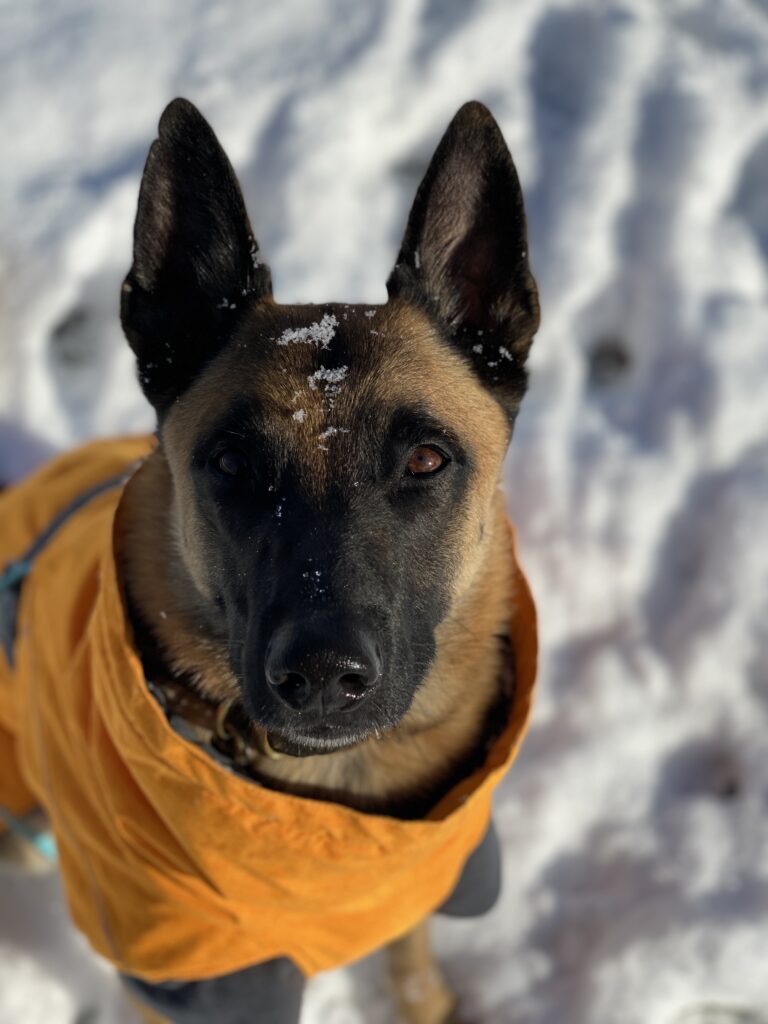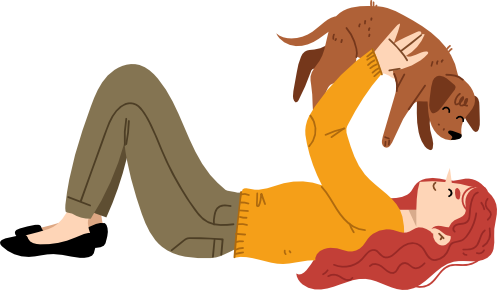Some dogs just don’t have good social skills and get into lots of fights. Other dogs are unflappable and never seem to “argue” with another dog. Most dogs fall somewhere in between. My older dog Barley will growl if other dogs try to take his treats and has gotten into fights if another dog jumps on him, but has never picked a fight. I’ve worked with many dogs who get into fights only with one sex of dog, dogs who dislike certain sizes of dogs, and dogs who just can’t stand one or two other dogs in their lives.
Today’s Ask a Behavior Consultant query revolves around another pattern of aggressive behavior that is quite common: dogs that escalate fights if another dog growls first. Moody Mastiff writes,
“My ten month old mastiff meets and plays with other dogs nicely however if another dog growls aggressively at her she snaps and gets into a quarrel. She has never drawn bloodI’m not sure if this is aggression or dominance and I do not know what to do about it.”
Is Dominance the Issue?
First off, we have great news for Moody Mastiff: this probably isn’t a dominance issue. Dominance relates to specific dog-dog relationships within a social group and over resources.
A dog that jumps into a confrontation whenever another dog growls isn’t expressing dominance over a resource; they’re escalating fights.
Why Does My Dog Escalate Fights When Other Dogs Growl?
As always, it’s hard to answer these “why” questions. We can’t exactly interview the mastiff to ask her. But here are some important factors in this case that may relate to your dog at home too.
- Age. Moody Mastiff’s pup is a 10 month old teenager. This is usually when aggression issues start to increase. The vast majority of my clients with behavior issues either discover these issues around 9-18 months old, after a traumatic event, or right away in puppyhood. As dogs hit teenagerhood, they’re pushing boundaries and learning who they are. They can be grouchy, emotional, and quick to take offense. Sounds a lot like human teenagers, huh? This doesn’t mean that Moody Mastiff is likely to grow out of this issue – it just means this is a very normal time for this behavior to show up. Mitigating the issue will still take lots of work!
- Breed. Mastiffs are not exactly renowned for their social skills with other dogs. In fact, they were specifically bred historically (and today in some cases) to quickly rise to the occasion when danger is detected. That means that when a border collie growls at a mastiff in order to ask for some extra space, the mastiff might read that warning as a challenge or threat. Their genetics tell them that it’s their job to eliminate that threat. We see similar patterns of behavior (escalating slights into fights) with a variety of other breeds, especially breeds bred for protection (many Mastiffs, German Shepherds, Belgian Malinois, livestock guardian dogs like Anatolian Shepherds and Great Pyrenees), game fighting (Bull Terriers, Bulldogs), vermin elimination (many terriers), and more.
- Social Skills. Just like people, dogs need to learn social skills from one another. With some work, many dogs can learn that another dog growling is just communication, not a threat. If your pup didn’t have ample opportunities to learn from other dogs at a young age, this skill can be more challenging to teach. It’s important for young dogs to learn to interact with (not just play) with a variety of dogs of other ages, breeds, and sizes. If your puppy only ever got to wrestle with other like-minded puppies, they didn’t necessarily learn how to take “no” for an answer from adults, more timid dogs, etc. At the same time, I have also met several more extreme puppies that even at 8-12 weeks of age displayed escalating aggression in puppy kindergarten. Simply subjecting the other puppies in class to that behavior is not an option, so teaching social skills to more extreme puppies can also be a huge challenge – even though they need it most!
- Learning History. What if the last 5 times another dog growled at your dog, that other dog then went on to attack your dog mere moments later? Your dog would likely learn that the best defense is a good offense. If your dog has learned that escalating fights is the best way to get the upper hand and stay safe, we’ve got a learning history issue on our hands.
- Health Issues or Pain. Many dogs get more defensive and aggressive when they’re painful. My older dog Barley is more likely to growl at his “nephew” Niffler (7 years younger) after a long hike when Barley is a bit sore. It’s hard to say if this is the case here, but in cases of escalating defensive aggression it’s important to check with the vet to rule out pain, GI upset, etc.
In the majority of cases, the actual “why” for a dog escalating fights is some combination of these factors. As we can see with Moody Mastiff, the dog is a teenage (1) mastiff (2). We don’t know for sure what her social skills (3), learning history (4), or health issues (5) may be, but I suspect at least one or two of those factors is also at play.
Understanding the “why” of a behavior is an important early step to making a plan to fixing the problem. If the dog is escalating fights because she’s scared or in pain, your responses may be a bit different than if the dog is escalating because of teenage hormones, and different yet if the dog is behaving due to protective/fighting instincts.
How Do I Stop My Dog from Escalating Fights When Other Dogs Growl?
Step 1: Identify Triggers
The first step to mitigating any behavior issue is to identify the triggers and then manage them.
In this case, your dog is broadly triggered to escalate a fight when another dog growls. But what other patterns can you identify? Consider:
- Does your dog have more issues with an individual dog? What about dogs of specific breeds or sizes? Or is it truly an issue with all other dogs?
- What makes the other dog growl? If you can avoid situations that make one dog growl, you can reduce fights. Common triggers include your dog invading that dog’s space, your dog approaching that dog’s food or toys or resting place, your dog startling that dog, or that dog being tired of playtime.
- Is your dog more irritable at certain times of day or after certain activities? Some dogs get cranky when they’re over- or under-exercised, hungry, sleepy, or feeling emotional (excited, nervous, etc) about other events going on. For example, I have witnessed dogs that normally get along well more likely to get into a fight right after seeing a squirrel or after an owner comes home from work – when emotions are running high.
Step 2: Mitigate Risk by Managing Triggers
Once you’ve identified some key patterns in your dog’s behavior, it’s time to systematically and thoroughly mitigate those triggers. Depending on the triggers, you may need to:
- Avoid dog parks
- Avoid greetings with unknown dogs
- Separate dogs during meals
- Separate dogs during times of high emotion like reunions after work
- Give both dogs plenty of time and space apart
- Pick up toys, bowls, and other prized possessions that could cause a squabble
In many cases, this alone may solve the problem. In my household, we don’t have any fights as long as I separate the dogs during meals or supervise them to ensure Barley doesn’t inhale his food and then come steal Niffler’s.
Step 3: Rebuild the Dogs’ Relationship as Needed
If the dogs need to continue interacting (such as housemates, neighbors, or frequent playmates due to human social structures), you may want to spend some time helping the dogs recover after the fight.
But if the dogs generally get along, the fight wasn’t so bad, and it would be hard to separate the dogs completely, you’ll want to reintroduce the dogs. This process can take anywhere from a few minutes to several weeks.
- Let the dogs calm down separately. There’s no need to rush a reintroduction if both dogs are still high on adrenaline or freaked out.
- Take the dogs on-leash to a neutral area for a walk. More space, more distractors, and more movement are better. In many cases the parallel walk method is a useful tool.
- Gradually reintroduce the dogs to more and more situations and freedom together – but avoid the situation that caused the initial fight!
If your dog consistently escalates into a fight when other dogs growl, I would NOT recommend allowing that dog to greet strange dogs or go to a dog park, period. It’s simply too risky that another dog/owner pair in public will behave a way you cannot predict or control.
If your dog is significantly larger than the other dog, the fight was injurious (one or both dogs needed veterinary care), the fight required intervention (someone had to physically separate the dogs), or one or both dogs struggled to calm down again after the fight (either due to fear or wanting to continue the fight), I would not recommend reintroducing the dogs without the help of a Certified Dog Behavior Consultant.
Step 4: Teach the Escalator Coping Skills
Teaching dogs social skills isn’t always easy – we’re only human. Our timing is therefore always a bit slow and a bit “off” to the dogs. Plus sometimes the interventions we attempt (pulling the dog away by the collar, yelling, stepping between the dogs) can actually add much more stress to the situation and cause a fight to escalate.
My preferred method is to teach the dog a disengagement skill: a hand target or recall works well here. Start by following the video and article for hand targets linked here. Then start using that hand target to call the dog away from neutral or boring interactions with people and dogs.
Once your dog is excellent at that (90% success), start using the hand target to call your dog away from playtime or other more fun activities with the other dog.
Finally, you can use the hand target to call your dog away from a tense situation that could escalate. Part of the point is to be able to interrupt your dog, yes. But more importantly, this teaches you dog that they don’t have to “choose violence:” they can simply walk away.
This simple method outlined here may not work for all dogs – it’s a very basic outline of a plan. If you’re still stuck, consider reaching out to Journey Dog Training or another Certified Dog Behavior Consultant for help.

